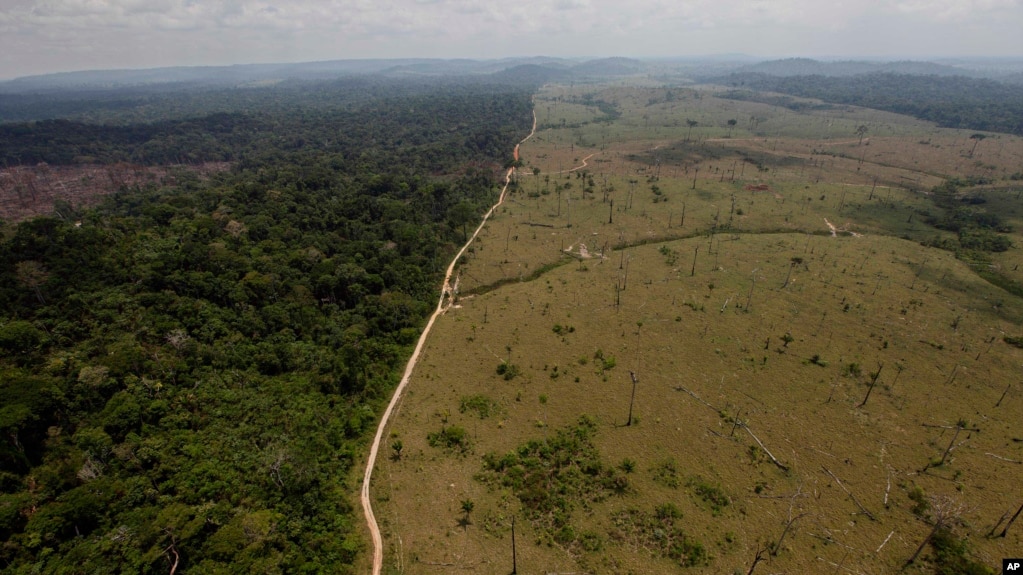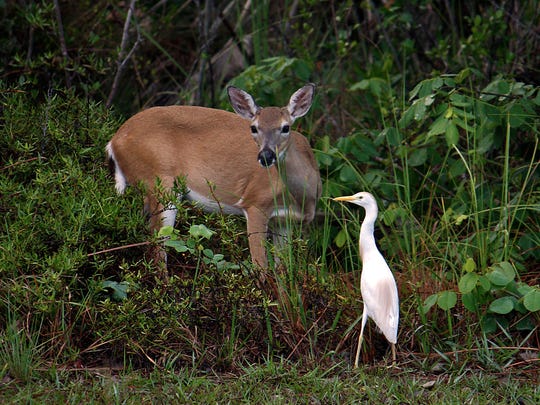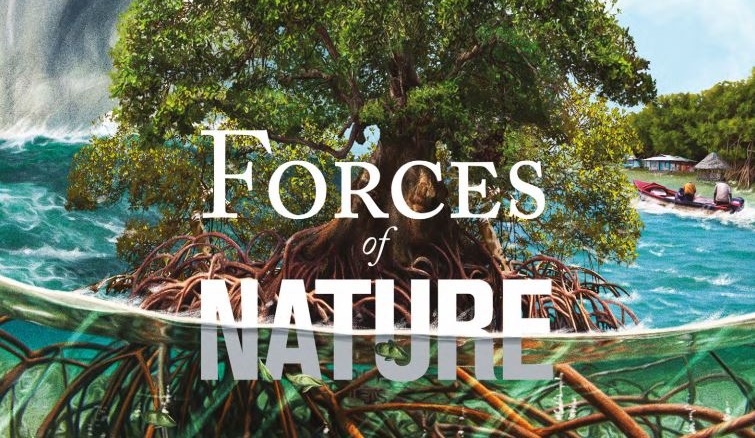FEATURE To fight climate change, Kenya mangroves work as carbon stores

KENYA – On the shores of the Indian Ocean, over a dozen people are circulating on a Kenyan North Coast beach, mangrove seeds in hand, while others are digging in the sand to plant new saplings of the native tree, which grows in brackish water. The beach is quite silent, with a gentle breeze sweeping over the salty water of the ocean, creating a mild wave crawling to shore. It is morning, with the sun looking like a bright ball floating on the water. Posing like a yellow lollipop on the horizon, the great light is on its daily mission to rise gradually to shine bright over the earth. The sea is calm, and the whole area is like a sacred space of coves and creeks along Kenya’s coast with an inlet visible in the distance letting all the ocean water in. “No one is paying us to conserve our mangrove forests, [but] here we are planting them,” said Timothy Mwakideu, wearing the type of shiny-dark silver sunglasses normally seen on the face of an astronaut. Timothy is a fisherman, but that day he skipped work to join a community-led mangrove conservation exercise. He said the locals used to like cutting mangroves for the excellent charcoal they got from them, but now they get more in return for conserving the mangrove forests, which are part of the Arabuko-Sokoke forest. READ MORE GLOBAL Protecting Natural Areas Not Enough to Safeguard Plants, Wildlife

GLOBAL – Scientists say expanding the world’s conservation areas to help protect animals and plant life is unlikely to be effective on its own. The reason: rising levels of human activity in and around protected natural areas. Cambridge University researchers studied thousands of conservation areas in more than 150 countries. They found that, in general, recognizing spaces as protected is not reducing human activity in at-risk areas. Across the northern hemisphere and Australia, protected areas often proved effective at slowing human activity when compared with unprotected areas. But in South America, Southeast Asia and African countries south of the Sahara Desert, pressure from human activity inside protected areas was notably higher. The study found agriculture is a major driving force behind human activity in protected areas. For example, African mangrove forests listed as protected experienced 13 percent greater losses to agriculture than unprotected mangrove areas between 1995 and 2010. READ MORE AFRICA Shaping a pan-African forest-landscape restoration exchange

CAMEROON – Two weeks after Malagasy Forest Landscape Restoration experts came to Yaoundé, their Cameroonian counterparts visited Madagascar to intensify their South-South exchange on Forest and Landscape Restoration (FLR) in Africa. The African Union Development Agency (AUDA) pilots targeted exchanges between member countries of the African Forest Landscape Restoration Initiative (AFR100) to foster peer-learning on FLR. “Cameroon is currently drafting its national FLR strategy and our role as AFR100 secretariat is to support this process,” AUDA’s Mamadou Diakhité explains. Madagascar is an ideal peer for Cameroon: The island country has pioneered the FLR movement by finalizing its national strategy in 2017 and advancing multi-sectoral and multilevel governance on the ground. To attain its commitment to restore 4 million hectares of degraded land, Madagascar established an inter-sectoral dialogue between relevant ministries and partners and elaborated framework documents for the implementation of FLR. The northwestern watersheds and mangroves of Boeny were the first sites the Cameroonian delegation inspected. READ MORE AMERICAS Species migration in Florida and beyond is causing environmental problems

USA – 2019 is on pace to be among the top three of the warmest years on record, according to the National Oceanic Atmospheric Administration. Nine of the 10 warmest years on record have occurred since 2005, with only the 1998 El Niño year as the anomaly. We're not the only animals that are feeling the heat. The fauna, fish and flora of Florida are feeling it too. And it's making them change their ways. Animals, fish, birds and even plants are starting to move north. It's creating problems. For the first time in more than 100 years, the Everglade snail kite is nesting north of Orlando. Last year, biologists were stunned to find four nests in Paynes Prairie just south of Gainesville. This year, there were 75. Snook, a fish with tropical characteristics susceptible to cold temperatures, once was a rare catch in waters north of Cape Canaveral or Homosassa. Anglers are catching them with regularity in Daytona and sometimes in the St. Johns River at Jacksonville. Red mangrove trees are "walking" their way up the coasts too. They are actually impinging on salt marsh habitat north of the Mosquito Lagoon, causing changes to habitat and moving the animals and birds that depend on that habitat to live. READ MORE Coastal Resilience Benefits of Mangroves in Jamaica

JAMAICA – Caribbean countries, including Jamaica, face substantial risks from storms and hurricanes. Coral reefs, mangroves, and seagrass beds protect communities from storms, and are critical for the sustainability of many economic activities, jobs, and inclusive growth. A recent report, “Forces of Nature,” examines the considerable flood risk reduction services that mangroves provide to Jamaica, together with benefits related to fisheries production, and carbon sequestration. This report supports the growing interest within the development agenda to include nature-based solutions for disaster risk management and provides vital information for discussion on climate change adaptation and mitigation, insurance, and disaster recovery decisions. Mangroves play a key role in protecting Jamaica against flood risks, and risk would be significantly increased if mangroves are lost. READ MORE ASIA Tropical Mangrove Ecosystems; the pulse of nature

SRI LANKA – A conference on the Rehabilitation and Protection of Tropical Mangrove Ecosystems was held at the Galle Face Hotel recently, calling to action students, state officials as well as environmentalists and conservationists to protect the island nation’s wetlands. The International Conference on Mangroves was organised by EMACE Sri Lanka in partnership with the German Ministry of International Cooperation and several other organisations from the region, with the aim to bring in experts and best practices to tropical mangrove ecosystems in Sri Lanka. Agricultural Scientist and Executive Director of the Global Nature Fund (GNF) Udo Gattenlöhner speaking at the event noted that while 70% of the mangrove ecosystems were lost over the last 100 years, the involvement of youth in protecting mangroves remains vital. Gattenlöhner who has worked with Sri Lankan experts for many years noted that sometimes natural disasters reflect how important mangroves are in protecting coastal communities. “Following the December 2004 Southeast Asian Tsunami, this disaster somehow enabled us to meet and initiate this partnership, to continue the work on conserving the biodiversity and the preservation of fresh water resources, lakes and wetland ecosystems,” he said. READ MORE Sri Lanka partners win presidential recognition

SRI-LANKA – Sudeesa, our partner NGO in the Sri Lanka Mangrove Conservation Project, received a prestigious award last month from president Maithripala Sirisena. Sirisena, whose term ended this month, presided over the annual awards ceremony, which recognized Sri Lankan institutions and individuals who have shown stewardship of the island country’s environment. Sudeesa was the only NGO to receive an award this year. READ MORE Cyclothon urges conservation of mangrove forests

INDIA – Odisha Paryavaran Sanrakshan Abhiyan in association with Dakshin Foundation and Aranyani Forest Officer s Wives Association organised its fourth state-level cyclothon to raise awareness about protection of mangrove forests here. Puri Wildlife Division DFO H B Udgata, Biju Patnaik Wildlife Conservation awardee Bichitranand Biswal and Forest Lady Charu Maa joined as honourable guests and appealed all to save the Mangroves. “Destruction of mangrove forests is due to lack of awareness. Hence, this is one of our main objectives. The event is aimed at boosting protection of Mangrove forests in Puri,” said Soumya Ranjan Biswal , co-founder, OPSA . Bichitrananda Biswal said, “Participants will engage in cycling for three days and nights. We want to spread the message of protecting mangrove forests. This is also a way to conserve the coasts .Let’s pledge to spread this message every year.” READ MORE Penaga mangroves to be made permanent forest

MALAYSIA – A top Penang official has given the assurance that a 600ha mangrove forest in the northwestern reaches of Seberang Perai would be carved out and marked as a permanent forest reserve.This endeavour is pending studies and legal formalities concerning the site, said state Environment Committee chairman Phee Boon Poh. This assurance came after The Star reported experts’ concerns that the area’s current land-use zoning of “industrial aquaculture” at the forest in Penaga, 11km north of Butterworth, might affect the haven for migratory birds that also serves as a natural defence against tsunamis. The daily reported that there is large aquaculture activity within the Penaga mangrove forests close to the shore facing the Malacca Straits. VIEW SOURCE On the frontline of disasters, mangroves at the receiving end of development and climate change

BANGLADESH – The Sundarbans mangroves in West Bengal, on the east coast of India, account for almost half of the total area under mangroves in the country. Apart from the east and west coasts of the mainland, mangroves are found and on the islands of Andaman and Nicobar and Lakshadweep. Indian mangroves represent 3.3 percent of global mangroves and about 56 percent of global mangrove species. As per Forest Survey of India estimates (2017), mangrove cover in the country is 4,921 square km, which is 0.15 percent of the total geographic area of the country. There has been a net increase of 181 square km in the country’s mangrove cover as compared to the 2015 assessment, according to the FSI report, though the number is debatable as conflicting data for certain stretches of mangroves is reported by non-governmental organisations. After West Bengal, Gujarat and Andaman and the Nicobar Islands have the maximum mangrove cover. Considering the growth and diversity, mangroves of Andaman and Nicobar are best in the country, said P. Ragavan of Council of Scientific and Industrial Research (CSIR), National Botanical Research Institute, Lucknow. READ MORE Pan Borneo Highway development endangers the Heart of Borneo

INDONESIA – A planned highway network in the Malaysian state of Sabah on the island of Borneo threatens the forests protected as part of the Heart of Borneo agreement made with Indonesia and Brunei, a new study has found. The goal of the agreement was to ensure the survival of continuous rainforest in central Borneo that houses wildlife populations, helps to mitigate climate change and fosters the island’s unique biology. But the construction and expansion of roads for the Pan Borneo Highway project could carve up the core of this ecosystem, the researchers who wrote the paper say. “We just know that these [roads] are going to have really severe effects in some of the last, sizable intact tracts of forest in Borneo and in the world,” William Laurance, a tropical ecologist at James Cook University in Australia and the study’s senior author, said in an interview. “Some of the planned highways are relatively benign, but several are flat-out dangerous,” Sean Sloan, the study’s lead author and an ecologist at James Cook University, said in a statement. “The worst roads, in southern Sabah, would chop up and isolate Sabah’s forests from the rest of those in Borneo.” In particular, a planned stretch between the towns of Kalabakan and Sapulut near Sabah’s southern border with the Indonesian province of North Kalimantan would slice through the Heart of Borneo conservation area. READ MORE Mangrove board walk set to open in Abu Ddhabi

ABU DHABI – What’s next for residents in Abu Dhabi? The Mangrove Boardwalk, a new hotspot for you to discover with your friends and family, and this time, it’s nature friendly, too. As the name suggests, the walk will overlook the natural setting of mangroves, and is located near Yas Island. It is set to open in January 2020 – and it doesn't come cheap. The project is estimated to cost up to Dhs5 billion, and will also cover 1 million square feet of the area. Impressive! Visitors will be able to take part in kayaking, participate in educational lessons, enjoy a play area for children, and chill on terraces where they can admire the stunning natural landscape and much more. The project aims to convey the importance of Mangrove trees and how they are essential for the environment. VIEW SOURCE LAST WORD Great Gift For The Holidays MAP's 202 Childrens Art Celndars are now available. These make great gifts to show your support of global climate efforts and are a helpful reminder for what we can do to assist in saving our world’s mangroves. Use the donation form below to select your calendar order, and receive a tax-deductible receipt for doing so – thank you! (Note: All costs include the cost of shipping – please select whether you will be shipping to a US or International address for according pricing.  CLICK HERE
Like this newsletter?
Pease consider donating to MAP to keep it going.
Giving could never be easier | ACTION ALERTS TROPIMUNDO 2020-2021 applications is now open TROPIMUNDO is an EC-funded and excellence-labelled Erasmus Mundus Joint Master Degree in Tropical Biodiversity and Ecosystems. MORE INFO PETITION – NO new coal power – protect local people and wildlife!
SIGN OUR PETITION PETITION – Help stop the advance of oil palm plantations in Gabon!
SIGN THE PETITION PETITION – Don't trash coral reefs for the cruise industry! – TAKE ACTION PETITION – Sea turtles or condominiums?
Sand mining and construction work would wipe out a marine biodiversity hotspot and destroy the livelihoods of local people, who have not been consulted. Please SIGN! PETITION – Save Penang! Reject the 3-Islands Reclamation!
The lack of public consultation and detailed information about the project is shocking in view of the size of proposed reclamation which is 4,500 acres or 7 square miles
PLEASE SIGN
PETITION – Save Pulau Kukup National Park – second largest mangrove island in the world. Sign The Petition Like this newsletter? Pease consider donating to MAP to keep it going. Giving could never be easier 
69 million tons of carbon stored thanks to mangrove restoration, as demonstrated by the new Mangrove Restoration Map VIEW MAP HERE 
Restoring The Natural Mangrove Forest
Watch movie 
Community Based Ecological Mangrove Restoration in Rufiji Delta VIEW VIDEO Video: Mangroves for the Future – A look bacK. As the latest phase of Mangroves for the Future (MFF) draws to a close, this video highlights some of the project’s most successful initiatives – from local women supporting national park management in Viet Nam to an island in the Maldives that has become a model for waste management, and everything in between. View Here WANT TO GET INVOLVED?
Follow and Join MAP!
   
Like this newsletter? Pease consider donating to MAP to keep it going. Giving could never be easier 

VOLUNTEER OPPORTUNITY 
MANGROVE ISSUES Want to learn more about mangroves?
Our short presentation will give you a better understanding of the issues we are working to solve. WATCH PRESENTATION What is CBEMR? Easy to follow fact sheet – CLICK HERE What is EPIC? – The Ecosystems Protecting Infrastructure and Communities (EPIC) project: the role of ecosystems as protective barriers against climate induced hazards MANGROVES APP AVAILABLE
A pictorial field guide for easy identification of various mangrove species and learning about the mangroves ecosystem. CLICK HERE View MAP’s uploaded Videos at MAPmangrover’sChannel
Question Your Shrimp Consumer/Markets Campaign!
WATCH VIDEO Mangrove Restoration in Asia – Watch Short Video The Value of Mangrove Forests View Video CBEMR Experience Exchange MAP 2017 English Subtitles
VIEW THE VIDEO Mangroves: Guidebook to Malaysia – Click Here
Mangrove rehabilitation in Asia – Local Action and cross-border Transfer of Knowledge for the Conservation of Climate, Forests and Biodiversity VIEW VIDEOS HERE SHARE MAP'S VISION
CLICK HERE to watch short introductory video. Together we can work "at the roots of the sea". Our short documentary, Reducing the Risk of Disaster through Nature-Based Solutions : Mangroves

Exclusive Interview with Alfredo Quarto, Co-Founder and Executive Director of Mangrove Action Project – See more
Marvellous Mangroves Curriculum The Marvellous Mangroves Education Forum is an online hub for those utilizing the Marvellous Mangroves (MM) Curriculum. It gives students, teachers and anyone interested in mangroves, the opportunity to learn and share ideas themed around the curriculum, to connect and communicate with others around the globe whilst exploring mangroves from your computer or on the go. VISIT 
The award-winning Marvellous Mangroves (MM) curriculum educates children on the importance of mangroves and their ecological functions, teaching them about modern challenges and mechanisms for sustainability. VIEW VIDEO Marvellous Mangroves Curriculum in Bangladesh – WATCH VIDEO
MARVELLOUS MANGROVES IN BRAZIL
En Portuges 
Marvellous Mangroves – A Curriculum-Based Teachers Guide. FOR MORE ON MAPs AWARD WINNING CHINA MANGROVE CURRICULUM VISIT

VIMEO SHOW
VISIT OUR "MM" WEBPAGE Check out our presentation for more details on Marvellous Mangroves Read this 10 page history of the development of MAP’s educational curriculum VIEW DOCUMENT
Article in Canada's Green Teacher Magazine – Read More
Like this newsletter? Pease consider donating to MAP to keep it going. Giving could never be easier 
Green Planet Fundraising Assists MAP – LEARN MORE
Volunteer Opportunities with Mangrove Action Project CLICK HERE
"Question Your Shrimp" Campaign Question Your Shrimp- Don't Buy or Sell Imported Tropical Shrimp! Sign the Petition Learn more about the affects of the shrimp industry on mangroves by visiting our blog
Editor’s Note: Mangrove Action Project’s Executive Director, Alfredo Quarto was interviewed about shrimp by Green Acre Radio’s Martha Baskin
LISTEN TO INTERVIEW Sign the Consumer's Pledge to avoid imported shrimp
Not yet a MAP News subscriber?
Click here to subscribe. Note to Our Readers: We strive to keep active links in our newsletter. However, due to circumstances beyond our control, occasionally links to stories may become broken. If you find a link to a story is not functioning, please cut and paste the headline into your browser search bar. In most cases you should be able to locate the original story.
|




























